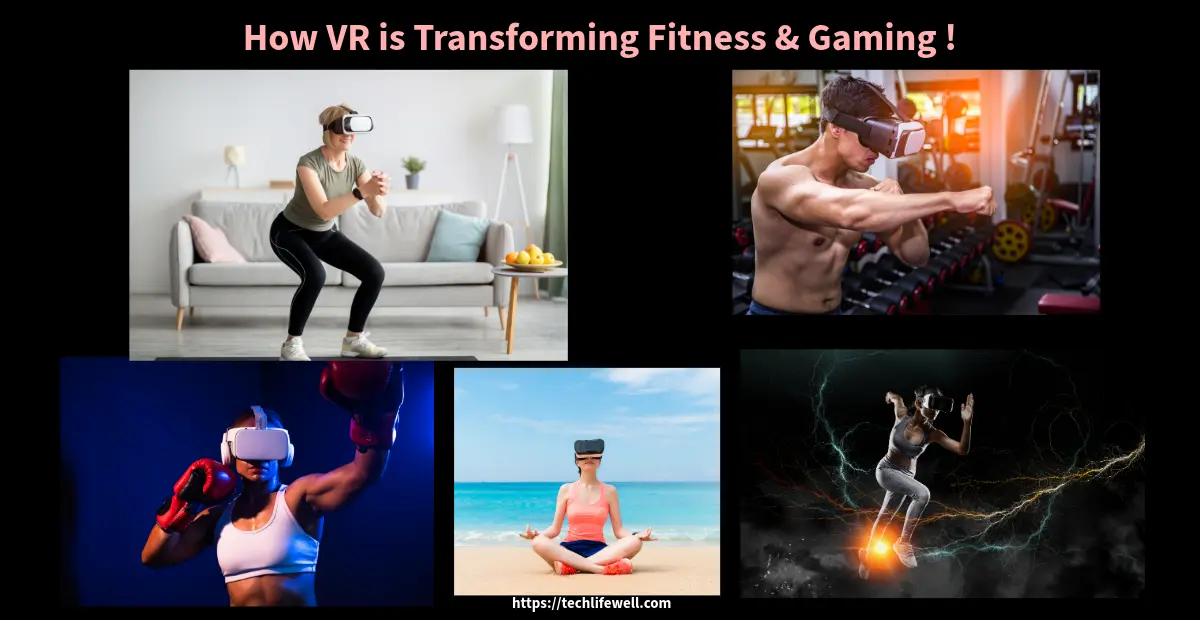Table of Contents:
Related Stories
Discover how virtual reality (VR) sets is revolutionizing fitness, blending gaming with full-body workouts for an immersive exercise experience. Explore the best VR fitness platforms, benefits, and tips to get started. Transform your fitness routine with the latest in VR technology. #VRfitness #VirtualRealityWorkout #ImmersiveExercise
VR has long been associated with gaming, offering players an escape into immersive worlds where the impossible becomes possible. However, VR is no longer confined to the gaming realm; it’s rapidly carving out a significant niche in the fitness industry. This technology is transforming how people approach exercise by blending the physical demands of a workout with the captivating allure of virtual environments. No longer are workouts limited to the gym or the living room; with VR, you can box in a futuristic ring, cycle through the French countryside, or dance on a neon-lit stage—all from the comfort of your home.
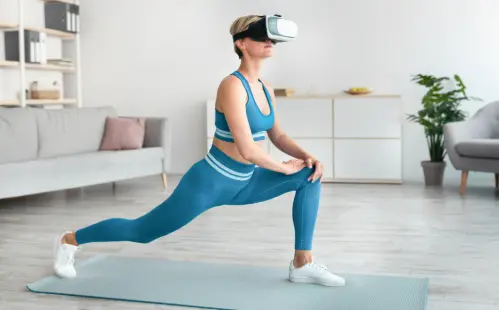
This blog delves deep into the world of VR fitness, exploring how it’s revolutionizing exercise routines and offering insights into the different types of VR fitness programs available today. We’ll also highlight the unique benefits of VR fitness, provide reviews of popular VR fitness platforms and devices, offer tips for beginners, and discuss potential drawbacks, such as motion sickness and the need for high-end equipment. Finally, we’ll look ahead to the future of VR in fitness, considering how it could further integrate with other health and wellness technologies.
The Evolution of VR in Fitness!
The concept of using technology to enhance physical fitness isn’t new. For decades, the fitness industry has embraced innovations, from heart rate monitors and pedometers to sophisticated smartwatches and AI-driven fitness apps. However, VR takes this a step further by creating fully immersive workout environments that engage both the body and the mind.
Initially, VR was a novelty, mostly explored by tech enthusiasts and gamers. Early applications focused on entertainment, with users exploring fantastical worlds or playing interactive games. However, as the technology advanced, it became clear that VR had the potential to do much more, particularly in the realm of fitness. Developers began creating VR experiences that required physical movement, turning passive entertainment into active participation.
Today, VR fitness is a burgeoning field, with a growing number of programs and devices designed specifically for exercise. These range from high-intensity workouts that rival traditional gym sessions to more relaxed, mindful activities like virtual yoga. As the technology continues to improve, the line between gaming and exercise is becoming increasingly blurred, offering users a new, exciting way to stay fit.
Types of VR Fitness Programs!
1. Dance-Based Workouts
One of the most popular categories of VR fitness is dance-based workouts. These programs are designed to get users moving to the rhythm of the music, often requiring them to follow choreographed routines or hit specific targets in time with the beat. Games like “Beat Saber,” “Synth Riders,” and “Dance Central VR” have become household names in the VR fitness community, offering a high-energy workout that feels more like a dance party than a traditional exercise session.
Beat Saber: Perhaps the most iconic VR fitness game, Beat Saber requires players to slice through blocks that fly toward them, synced to the beat of energetic music. The game is simple yet highly addictive, with increasingly challenging levels that test both physical endurance and hand-eye coordination. As players progress, the pace quickens, turning what starts as a light workout into an intense cardio session.
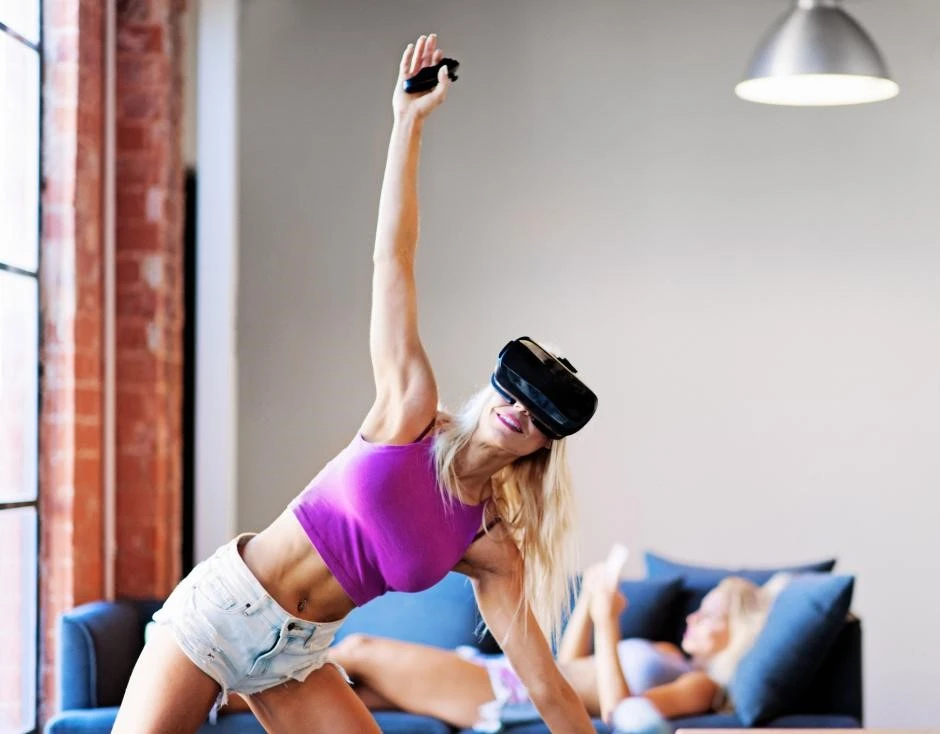
Synth Riders: Similar to Beat Saber, Synth Riders involves hitting targets in time with music, but with an emphasis on dance-like movements. The game offers a more fluid and expressive experience, encouraging users to move their entire bodies as they follow the rhythm. This makes it a great option for those who enjoy dance and want to incorporate it into their fitness routine.
Dance Central VR: This game brings the experience of a dance studio into your living room. With routines choreographed by professional dancers and a wide range of music genres to choose from, Dance Central VR provides a comprehensive workout that combines cardio with coordination. The game also includes multiplayer modes, allowing users to dance with friends or compete against others online.
2. Virtual Cycling
Cycling is a popular form of cardiovascular exercise, but indoor cycling can sometimes feel monotonous. VR changes that by transporting users to virtual landscapes, from scenic coastal roads to bustling city streets, making the experience more engaging and enjoyable.
VirZOOM: VirZOOM pairs with a stationary bike and offers a variety of cycling experiences, from racing through cityscapes to flying on the back of a Pegasus. The platform is designed to be both entertaining and physically demanding, with challenges that test endurance and speed. VirZOOM also includes multiplayer options, allowing users to race against friends or other players from around the world.
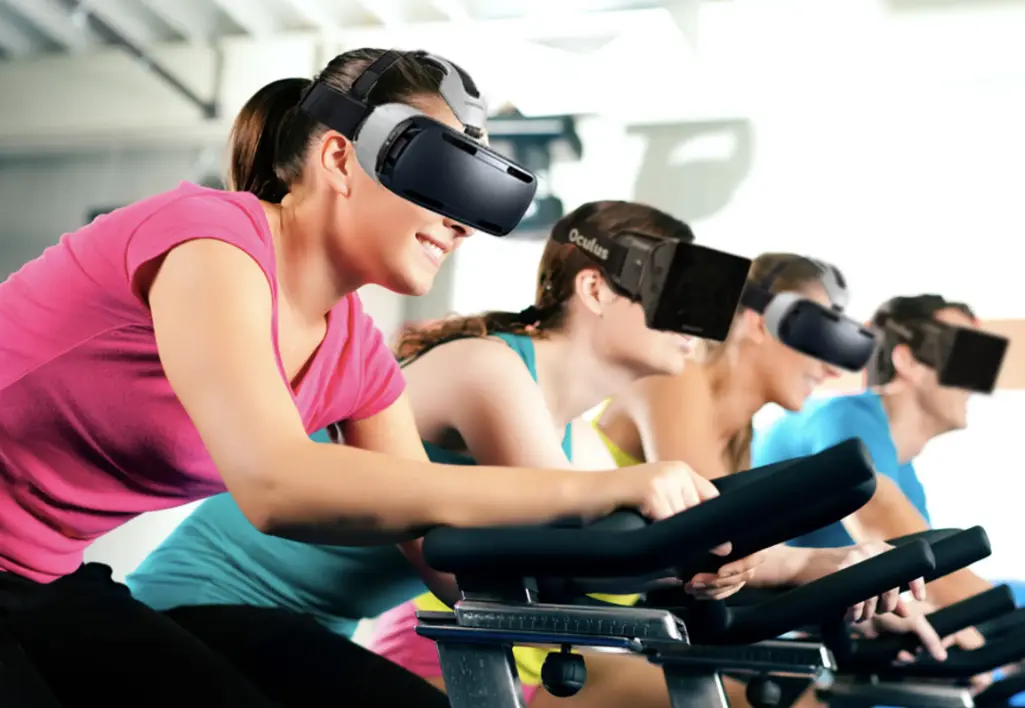
Holodia: Holodia’s HOLOFIT is another popular VR cycling program that offers users the chance to ride through stunning virtual environments. Whether you’re cycling through ancient ruins or futuristic cities, the immersive nature of Holodia’s worlds makes workouts feel less like exercise and more like an adventure. The program also includes various workout modes, such as interval training and endurance challenges, catering to different fitness levels.
3. Boxing and Martial Arts
For those looking to combine cardio with strength training, VR boxing and martial arts programs offer a challenging and rewarding workout. These games require users to throw punches, dodge attacks, and maintain their stance, providing a full-body workout that targets the upper body, core, and legs.
Thrill of the Fight: Considered one of the most realistic boxing simulations available in VR, Thrill of the Fight requires users to use real boxing techniques to defeat their opponents. The game’s physics engine ensures that every punch, block, and dodge feels authentic, providing an intense workout that rivals traditional boxing training. Users report significant improvements in their stamina, strength, and reflexes after regular sessions.

Creed: Rise to Glory: Based on the popular Creed movie franchise, this game puts players in the shoes of a professional boxer working their way up the ranks. The game’s cinematic presentation and engaging storyline make it feel like you’re training for a real fight, while the physical demands of the gameplay ensure that you’re getting a serious workout.
4. Yoga and Mindfulness
While many VR fitness programs focus on high-intensity workouts, there are also options for those seeking a more relaxed and mindful experience. VR yoga and mindfulness programs transport users to serene virtual environments where they can practice yoga, meditation, and deep breathing exercises.
Guided Meditation VR: This app offers over 30 environments for meditation, ranging from tranquil beaches to peaceful forests. It includes guided sessions for different levels of experience and goals, such as stress relief, focus, and sleep improvement. Guided Meditation VR is ideal for those looking to integrate mindfulness into their daily routine, offering a virtual escape from the stresses of everyday life.
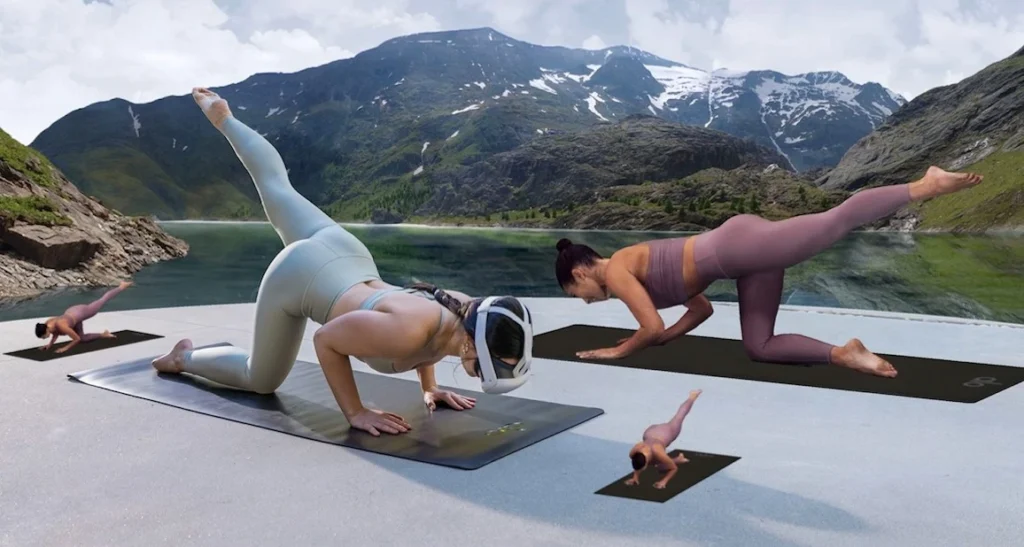
Yoga for Beginners: As the name suggests, this program is designed for those new to yoga. It offers a series of guided yoga sessions in beautiful virtual environments, helping users learn the basics of yoga at their own pace. The app’s virtual instructor provides clear instructions and adjustments, making it easy for beginners to follow along and improve their practice over time.
Unique Benefits of VR Fitness!
1. Increased Motivation Through Gamification
One of the most significant advantages of VR fitness is its ability to increase motivation through gamification. Traditional workouts can sometimes feel monotonous, leading to a lack of motivation and consistency. However, VR fitness turns exercise into a game, where users can earn points, unlock achievements, and compete against others. This gamified approach makes workouts more enjoyable and engaging, encouraging users to stay consistent with their fitness routines.
Gamification taps into the competitive nature of many individuals, motivating them to push themselves harder to achieve higher scores or complete challenging levels. This competitive element can be particularly effective for those who struggle with staying motivated in traditional workout settings. Additionally, the immediate feedback provided by VR fitness programs, such as seeing your score improve or advancing to the next level, can create a sense of accomplishment that reinforces positive behavior.
2. Real-Time Progress Tracking
Another significant benefit of VR fitness is the ability to track progress in real-time. Many VR fitness programs are equipped with tracking features that monitor various aspects of the workout, such as calories burned, heart rate, and time spent exercising. This data is often displayed on the screen during the workout, allowing users to see their progress and make adjustments as needed.
Real-time progress tracking provides valuable feedback that can help users improve their performance over time. It also allows for a more personalized workout experience, as users can set goals and track their progress toward achieving them. The ability to see immediate results, whether it’s calories burned or progress in a game, can also help to keep users motivated and engaged in their fitness journey.
3. Convenience of Working Out at Home
The convenience of working out at home is another major advantage of VR fitness. Traditional fitness routines often require a gym membership or attendance at fitness classes, which can be time-consuming and costly. VR fitness eliminates the need for these external resources, allowing users to work out in the comfort of their own homes.
Working out at home provides more flexibility in terms of scheduling. Users can fit in a workout whenever it’s convenient for them, without having to adhere to gym hours or class schedules. This flexibility makes it easier for individuals with busy lifestyles to stay consistent with their fitness routines. Additionally, VR fitness removes the barriers of bad weather, commute times, and the need for specialized equipment, making it an accessible option for many people.
4. Community and Social Interaction
Despite being a solitary activity, VR fitness offers opportunities for community and social interaction. Many VR fitness programs include multiplayer features, allowing users to work out with friends or join virtual fitness communities. These social features can enhance the workout experience, providing a sense of camaraderie and accountability.
Working out with others, even in a virtual setting, can make exercise more enjoyable and motivating. It also provides an opportunity to connect with like-minded individuals who share similar fitness goals. For those who may feel isolated or unmotivated when working out alone, the social aspects of VR fitness can provide a valuable source of support and encouragement. Platforms like Supernatural even offer daily live workouts led by real coaches, allowing users to interact with instructors and other participants in real time.
Popular VR Fitness Platforms and Devices!
1. Meta Quest 3

The Meta Quest 3 is one of the most popular VR headsets on the market and is widely used for VR fitness. Its wireless design and high-quality display make it ideal for immersive workouts, while its relatively affordable price point makes it accessible to a broader audience.
The Meta Quest 3 supports a wide range of VR fitness apps, including Beat Saber, Supernatural, and FitXR. It also features built-in tracking for movements and heart rate, making it easier to monitor progress during workouts. The device’s library of fitness content is continually expanding, offering users a growing selection of workout options.
2. PlayStation VR

For those who already own a PlayStation console, PlayStation VR is a convenient option for getting started with VR fitness. The platform offers a variety of fitness games, including boxing, dancing, and rhythm-based workouts. While it may not offer the same level of immersion as the Meta Quest 3, PlayStation VR provides a solid VR fitness experience, particularly for those who are new to the technology.
3. HTC Vive

The HTC Vive is another high-end VR headset that is well-suited for fitness. Its advanced tracking capabilities and wide field of view make it ideal for more intense, movement-based workouts. The HTC Vive is compatible with a variety of fitness apps, including Thrill of the Fight and Creed: Rise to Glory, making it a great choice for those who are serious about incorporating VR into their fitness routine.
4. Supernatural
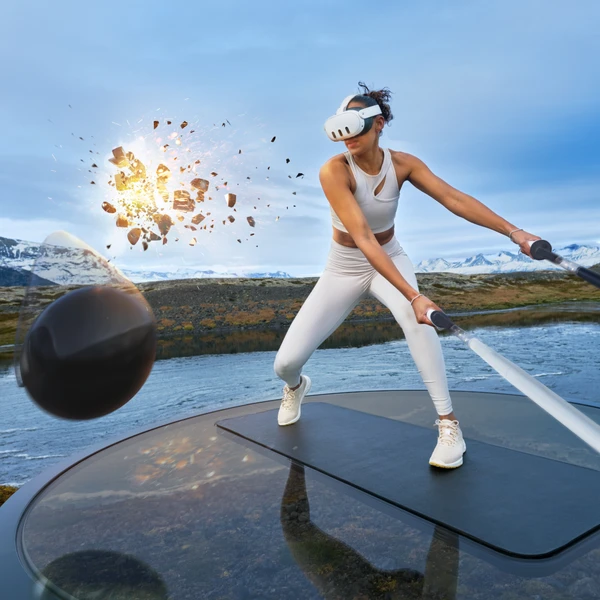
Supernatural is a subscription-based VR fitness app available on the Meta Quest 3. It offers a variety of workouts, including cardio, strength training, and stretching, all set to beautiful, immersive environments. Supernatural also features daily live workouts led by real coaches, providing users with a guided, personalized experience.
The app’s combination of stunning visuals, engaging workouts, and real-time coaching has made it one of the most popular VR fitness platforms. While it requires a monthly subscription, many users find the investment worthwhile for the variety and quality of the workouts provided.
Getting Started with VR Fitness: Tips for Beginners!
If you’re new to VR fitness, getting started can feel a bit overwhelming. However, with the right approach, you can quickly get up to speed and start enjoying the benefits of this innovative form of exercise. Here are some tips for beginners:
Start Slowly: If you’re new to VR fitness, it’s important to start slowly and gradually increase the intensity of your workouts. Begin with shorter sessions and lower-intensity workouts to allow your body to adjust to the new form of exercise.
Choose the Right Equipment: Invest in a quality VR headset, such as the Meta Quest 3 or HTC Vive, to ensure you have a comfortable and immersive experience. Make sure your play area is clear of obstacles to avoid accidents.
Explore Different Programs: There are many different types of VR fitness programs available, so take the time to explore different options to find what you enjoy the most. Whether it’s dancing, boxing, or cycling, choose programs that align with your fitness goals and interests.
Take Breaks: VR workouts can be intense, so it’s important to take breaks as needed. Pay attention to how your body feels and don’t push yourself too hard, especially in the beginning.
Join a Community: Many VR fitness platforms offer social features that allow you to connect with other users. Joining a community can provide motivation, support, and a sense of accountability as you embark on your VR fitness journey.
Be Mindful of Motion Sickness: Some users may experience motion sickness when using VR, particularly during more intense workouts. If you’re prone to motion sickness, start with lower-intensity programs and gradually work your way up. Some platforms also offer settings to reduce motion sickness, such as adjusting the field of view or using a stationary frame of reference.
Potential Drawbacks of VR Fitness and Solutions!
While VR fitness offers many benefits, it’s important to be aware of potential drawbacks and how to address them.
1. Motion Sickness
As mentioned earlier, motion sickness can be a concern for some users. This occurs when the movement perceived in the virtual environment doesn’t match the movement sensed by the body, leading to feelings of nausea and dizziness. To mitigate this, start with less intense workouts and gradually build up your tolerance. Additionally, adjusting the VR settings, such as reducing the field of view or using a stationary frame of reference, can help reduce motion sickness.
2. High-End Equipment Costs
One of the barriers to entry for VR fitness is the cost of high-end equipment. Quality VR headsets and accessories can be expensive, which may be a deterrent for some users. However, the cost of VR equipment has been decreasing over time, and there are now more affordable options available, such as the Meta Quest 2. Additionally, consider starting with a more budget-friendly headset and upgrading later as you become more committed to VR fitness.
3. Physical Space Requirements
VR fitness requires a certain amount of physical space to move around safely. This can be a challenge for those living in smaller apartments or homes. To address this, choose VR fitness programs that require minimal movement or use seated or stationary options. Additionally, clear out as much space as possible before starting your workout to reduce the risk of accidents.
The Future of VR in Fitness!
The future of VR in fitness is promising, with potential advancements that could further revolutionize how we approach exercise. As technology continues to evolve, we can expect to see even more immersive and interactive fitness experiences that blur the lines between gaming and working out.
1. Integration with Other Health and Wellness Technologies
One exciting development is the potential integration of VR fitness with other health and wellness technologies. For example, combining VR workouts with wearable fitness trackers could provide more comprehensive data on a user’s performance and health metrics. This integration could lead to more personalized workout experiences, where VR programs adapt to a user’s fitness level, goals, and progress in real-time.
2. Advancements in Haptic Feedback
Haptic feedback technology, which provides tactile sensations to simulate touch, is another area of potential growth in VR fitness. Advanced haptic feedback could make VR workouts even more immersive, allowing users to feel the resistance of weights, the impact of punches, or the texture of virtual surfaces. This could enhance the realism of VR fitness programs and provide a more engaging and effective workout experience.
3. Expanded Content and Accessibility
As VR technology becomes more mainstream, we can expect to see an expansion in the content and accessibility of VR fitness. More fitness programs will likely be developed, catering to a wider range of interests and fitness levels. Additionally, as the cost of VR equipment continues to decrease, VR fitness will become more accessible to a broader audience, democratizing access to high-quality fitness experiences.
Conclusion:
Virtual Reality is transforming the fitness industry by offering immersive, engaging, and effective workout experiences. Whether you’re dancing to the beat in a neon-lit world, boxing in a futuristic ring, or cycling through virtual landscapes, VR fitness provides a unique way to stay active and motivated. With the convenience of working out at home, the ability to track progress in real-time, and the opportunity to connect with a virtual fitness community, VR fitness is revolutionizing how people approach exercise.
While there are potential drawbacks, such as motion sickness and the cost of high-end equipment, these can be mitigated with the right approach. As technology continues to advance, the future of VR in fitness looks bright, with potential integrations with other health and wellness technologies and advancements in haptic feedback.
For those looking to shake up their fitness routine and explore the intersection of technology and exercise, VR fitness offers a promising and exciting path forward. Whether you’re a seasoned athlete or a fitness novice, there’s something for everyone in the world of VR fitness. So why not take the plunge and experience the future of fitness today?
References:
Supernatural: Supernatural Website
HTC Vive: HTC Vive Website
Beat Saber: Beat Saber Website
Synth Riders: Synth Riders Website
VirZOOM: VirZOOM Website
Holodia: HOLOFIT Website
This post offers a comprehensive look at how VR is transforming fitness, providing a blend of detailed analysis, practical tips, and forward-looking perspectives to engage readers and keep them informed about this exciting development in the fitness world.
